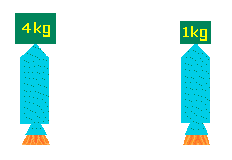 |
| Gary Novak Background
|
1. Quick Summary of Proof 
The proof shows that the fuel used by a rocket does not correlate with the addition of ½mv² but the addition of mv of an attached mass. To show this, a rocket is applied to the falling object issue. The math is shown on the falling object page and rocket page. Part One: Neither force x distance nor ½mv² is kinentic energy. A 4kg object dropped 1m (meter) has the same amount of ½mv² as a 1kg object dropped 4m, because force times distance equals ½mv² for an accelerating mass. But a rocket accelerating the masses to those velocities requires twice as much energy as fuel for the large mass as for the small one.* Therefore, both masses do not have the same energy; the rocket does not transform energy in proportion to ½mv²; ½mv² is not kinetic energy; and a gallon of fuel does not produce a consistent amount of ½mv². Part Two: mv (momentum) is kinetic energy. A 4kg object dropped for 1s (second) has the same amount of mv (momentum) as a 1kg object dropped for 4s, because force times time equals mv for an accelerating mass. A rocket accelerating the masses to those velocities uses the same amount of energy as fuel for both masses.
Therefore, both masses have the same amount of energy; the rocket transforms energy in proportion to mv; mv is kinetic energy; and a gallon of fuel produces a consistent amount of mv. In other words, the rate of energy use (power) by a rocket engine is proportional to the increase in momentum of the foward mass, not the ½mv² of the forward mass. *Note. The calculated energy applies only to the mass in question, not the rocket mass; and there is zero error in the calculation. Mathematics (rocket page) |